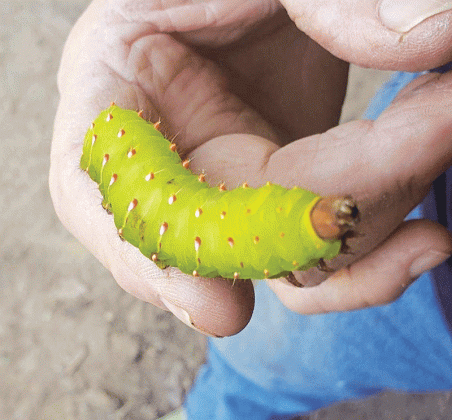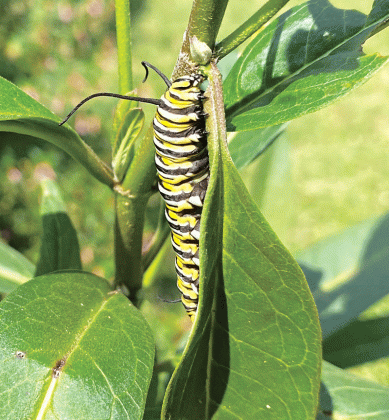

Heather Kirk-Ballard / LSU AgCenter horticulturist
If you’ve spent any time outside or in the garden here lately, you are sure to have noticed a frenzy of insect activity. Insects, including bees, butterflies, caterpillars and moths, are in full force this fall.
Fall is especially busy for caterpillars. According to LSU AgCenter entomologist Nathan Lord, insects, especially lepidopterans such as butterflies and moths, have two main periods of activity in Louisiana. Early spring in March and April and again in fall during October through December.
Butterflies and moths have four life stages: egg, larva, pupa and adult. Caterpillars are the second stage, called larva in the life cycle. At this point, they spend most of their time eating leaves of various plants and growing at an exponential rate.
Insects work diligently to ensure the survival of their offspring. Fall is their last effort at a boom of diversity before going into winter diapause (dormancy). Adult butterflies and moths are actively mating and laying eggs that will lay dormant until temperatures are again favorable in spring. Other caterpillars are pupating in chrysalises and cocoons and overwintering to emerge as adults the following spring.
At this time of year, caterpillars spend the majority of their time eating. They are filling up on various plant foliage. Many caterpillars have very specific host plants, such monarch caterpillars on milkweed, Gulf fritillary on passionflower vine and giant swallowtail on citrus fruit. Host plants are often native annuals, perennial wildflowers, shrubs and trees that adult butterflies will search for to lay their eggs. Some caterpillars will devour anything, and oaks are considered the universal food.
Luckily for curious observers, caterpillars are slow movers. At this stage, insects are visible by their striking colors, and some have spines or fuzzy hairs. Those with spines and hairs are typically stingers, but not always. Other caterpillars have evolved to mimic stingers to deter predators.
Hungry, hungry caterpillars can cause some damage to plants. But in most cases the damage is not devastating and can be tolerated with no real consequence to overall growth or quality. Defoliated plants will flush out new leaves quickly in most cases.
Some of the most visible caterpillars this time of year are the monarch, Gulf fritillary, luna moth, giant swallowtail, sphinx moths, tent caterpillars and so many more.
Many native trees are host plants to a number of beautiful butterflies and moths. “Louisiana Native Pollinator Trees” by Chrissy Mogren is a wonderful reference. It can be found online at http://bit.ly/lslupollinatortrees.
In this publication she notes that many native trees such as buttonbush, goldenrod, parsley hawthorn, persimmon and tulip poplar provide nectar for many different butterflies while many other native trees and shrubs provide food for caterpillar larvae.
Mogren’s list of butterfly and moth caterpillars and their host plants include the following:
— Gray hairstreaks feed on clover, cotton, mallow and pecan. Juniper hairstreaks, as the name implies, prefer junipers and red cedars. Striped hairstreak caterpillars can be found on ironwoods and oak while adult butterflies sip nectar from goldenrod, milkweed and viburnums such as the Louisiana Super Plant, Mrs. Schiller’s Delight viburnum.
— Hackberry emperor feeds on several species of hackberry while mourning cloak, question mark and painted lady caterpillars all feed on American elm.
— Willow trees are the host plant of the viceroy butterflies that closely resemble the monarch, and eastern tiger swallowtails can be found on tulip poplar, ironwood and willow. Zebra swallowtails can be found only on pawpaw trees.
— Spotted aptelodes host plants include ash, maple and oak. Red-spotted purple caterpillars can be found on oak, willow and ironwood trees. Banded tussock moth caterpillars and adult moths feed on ash, elm and hackberry.
— Luna moth host trees include alder, beech, black walnut, butternut, hickory, pecan, persimmon, sweet gum, sumac and willow. Promethea moth host plants include black cherry and sweetbay magnolia.
— Rosy maple moths are specific to red maple. Tulip tree silk moth prefers tulip poplar trees, and the bald cypress sphinx moth is host-specific to the bald cypress.
— Hydrangea sphinx moth larval host plants include hydrangea and buttonbush, and pawpaw sphinx larval host plants include pawpaw, some species of holly and inkberry.
— Rustic sphinx caterpillar host plants include fringe tree and Grancy greybeard while small-eyed sphinx feed on a variety of plants, including black cherry, chokecherry, sour cherry, serviceberry and basswood.
— The spicebush swallowtail feed on spicebush, camphor tree, sassafras and red bay, and the woolly worm or banded woolly bear devours dandelion, aster, birch and goldenrod so prominent in the fall.
At this time at the end of the growing season for deciduous trees, these beautiful critters provide an insight into the natural world of wonder for children and adults alike.
If you enjoy seeing these caterpillars, many host plants are available for luring insects, and native plants are the best way to go. Don’t forget native milkweeds, passion flower vine and citrus.
By adding host plants and trees to your landscape, you can attract beautiful butterflies and moths each season while providing habitat for the pollinators and other wildlife. In addition, you’re adding natural beauty and wonder to your landscape.
Cutlines –
Gulf fritillary caterpillar in mid-chrysalis formation. A full chrysalis can be seen above on upper branch. (Photo by Heather Kirk-Ballard/LSU AgCenter)
Luna moth caterpillar found on a pecan tree. (Photo by Heather Kirk-Ballard/LSU AgCenter)
Sphinx moth caterpillar on native perennial native flower. (Photo by Heather Kirk-Ballard/LSU AgCenter)
Monarch butterfly caterpillar on host plant milkweed. (Photo by Heather Kirk-Ballard/LSU AgCenter)
